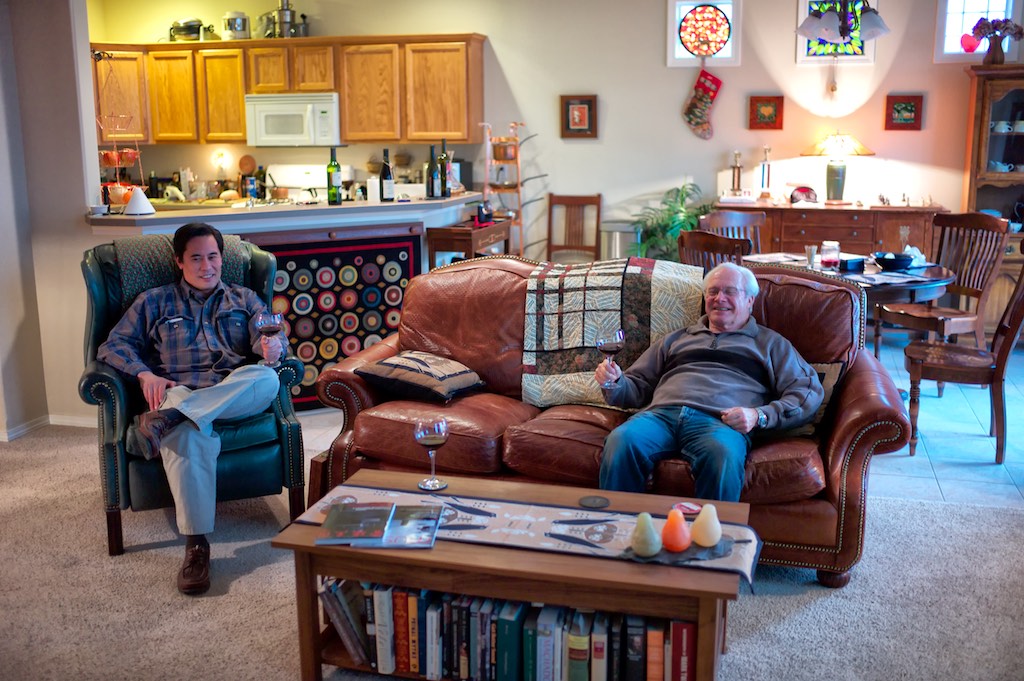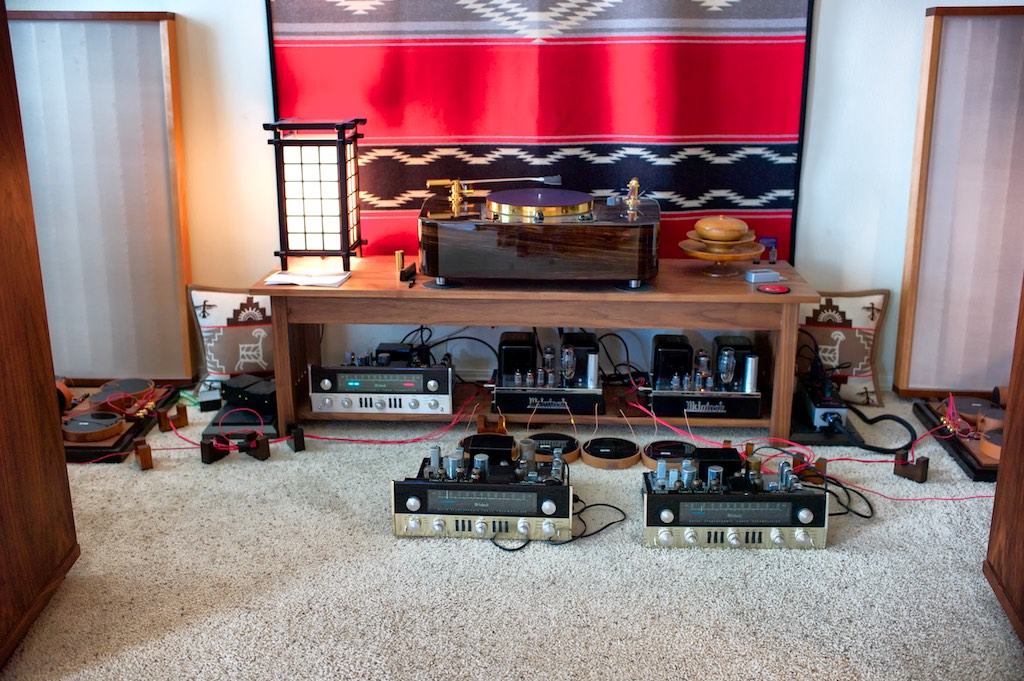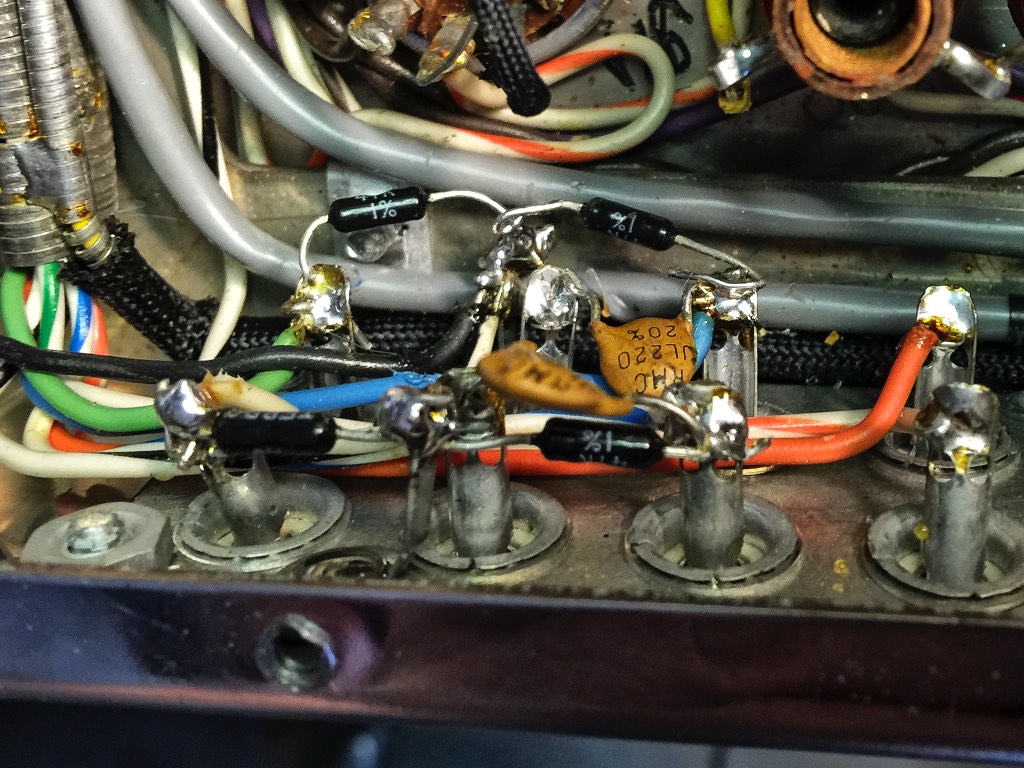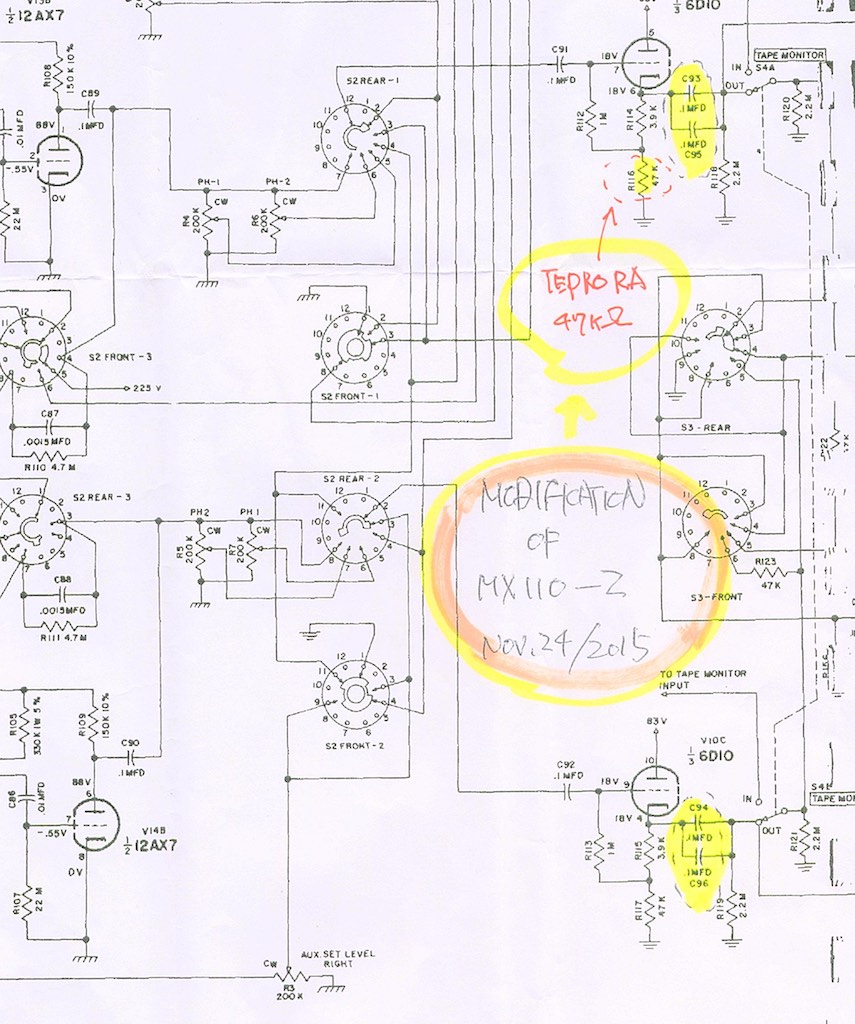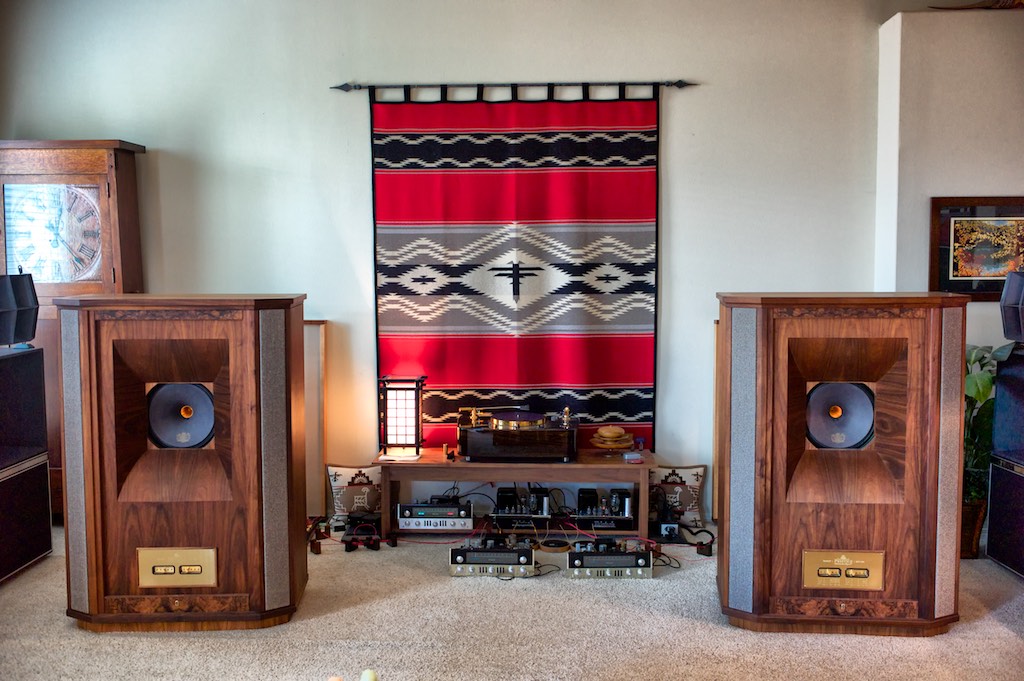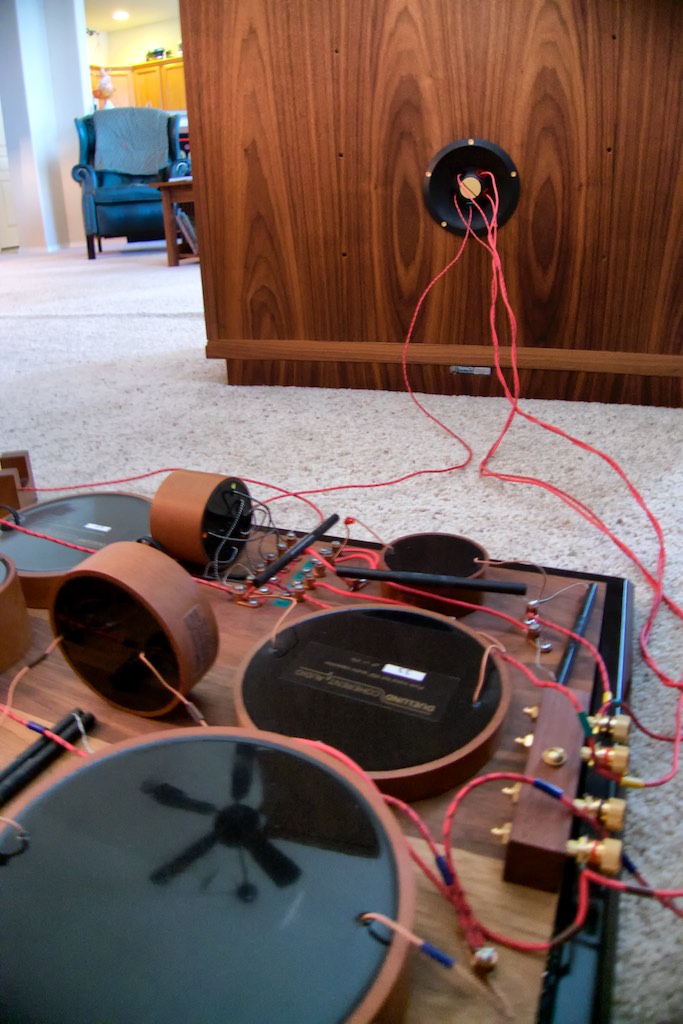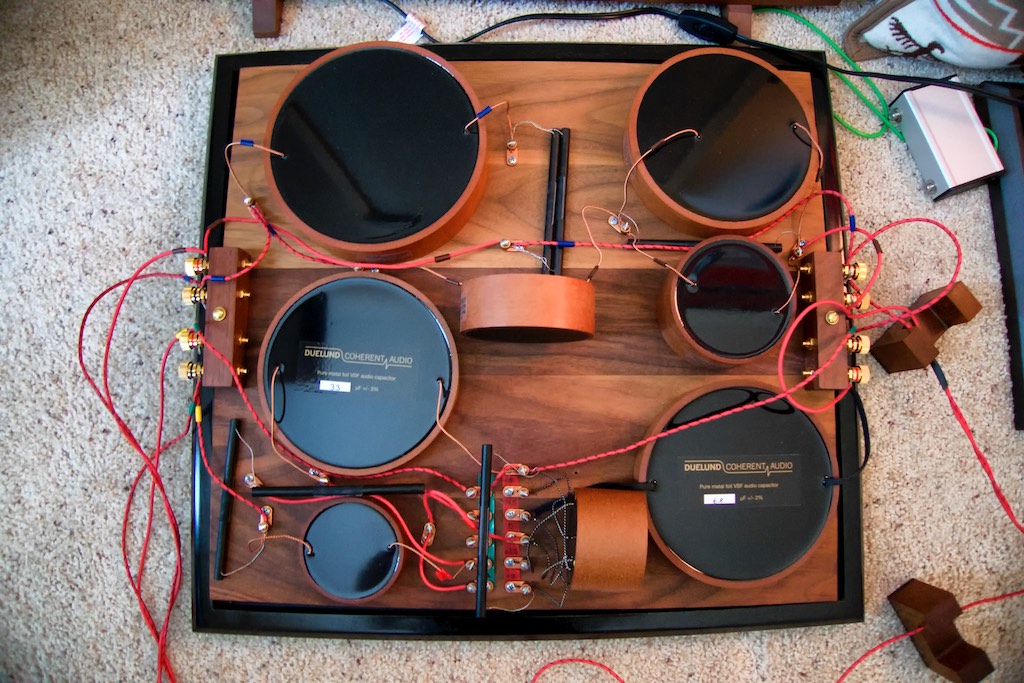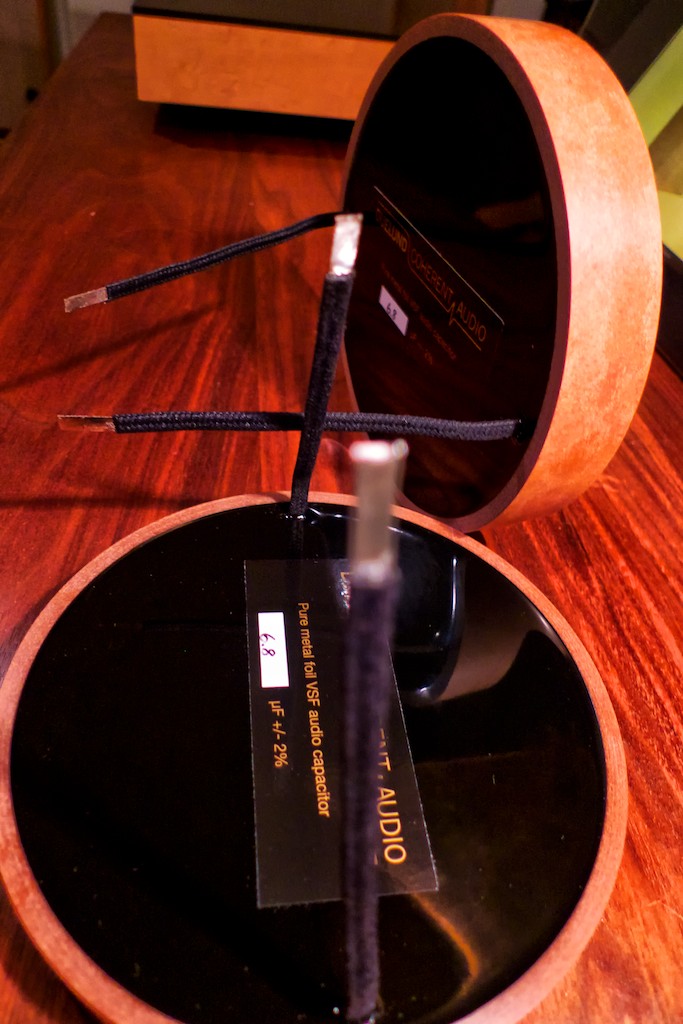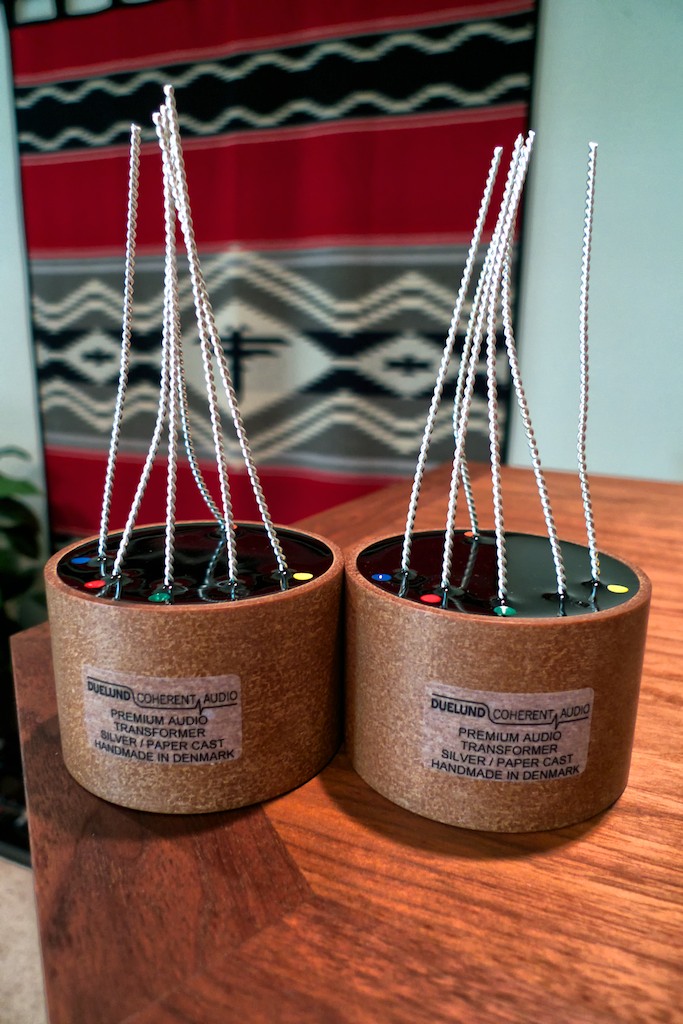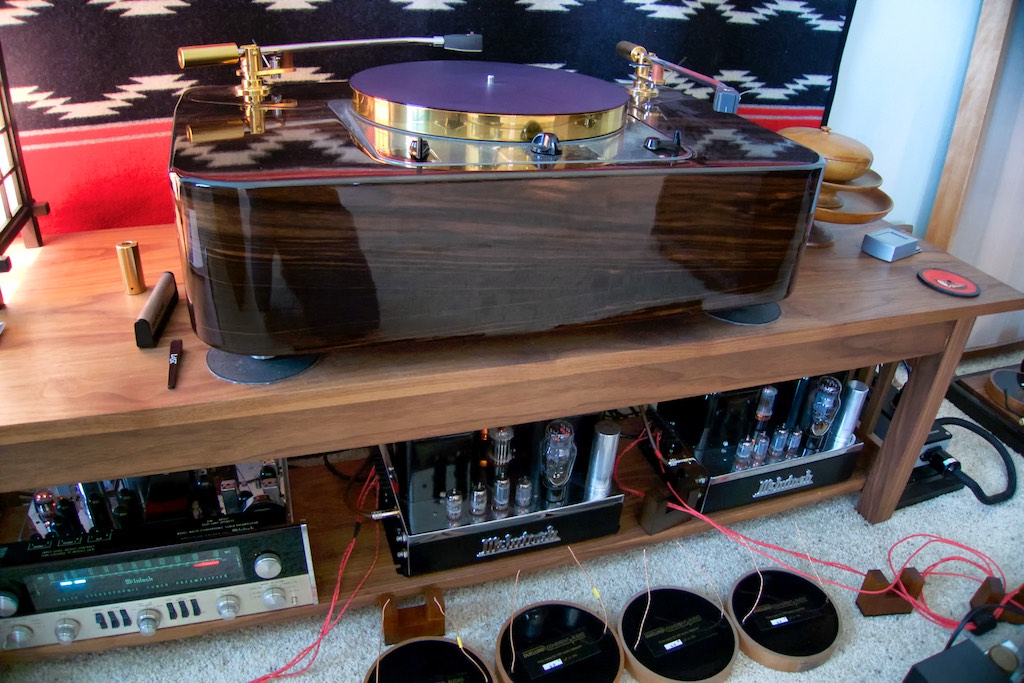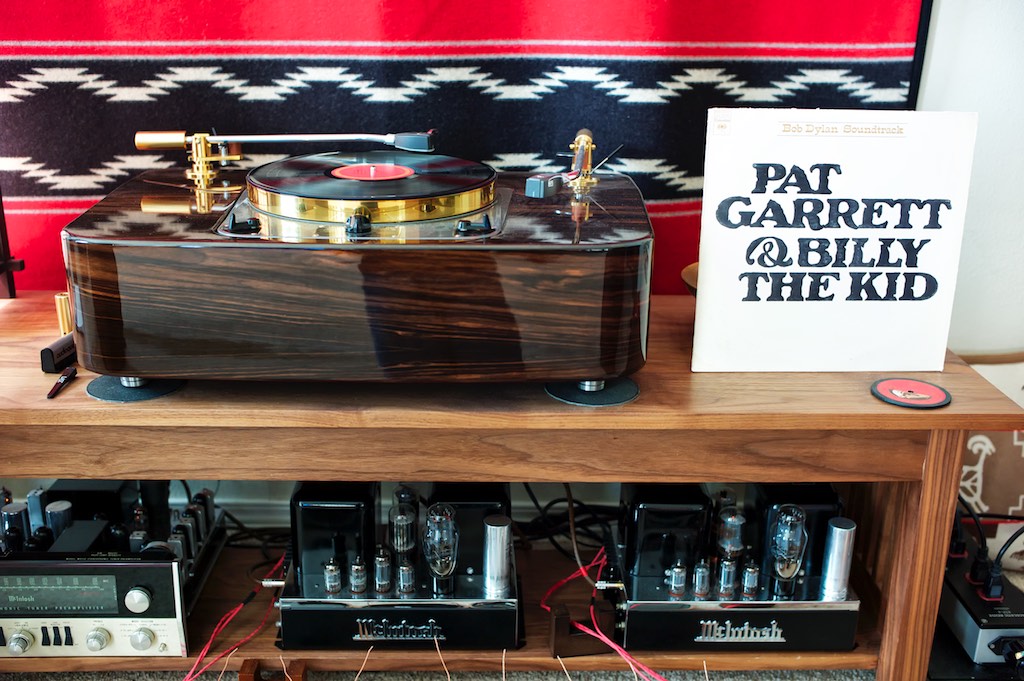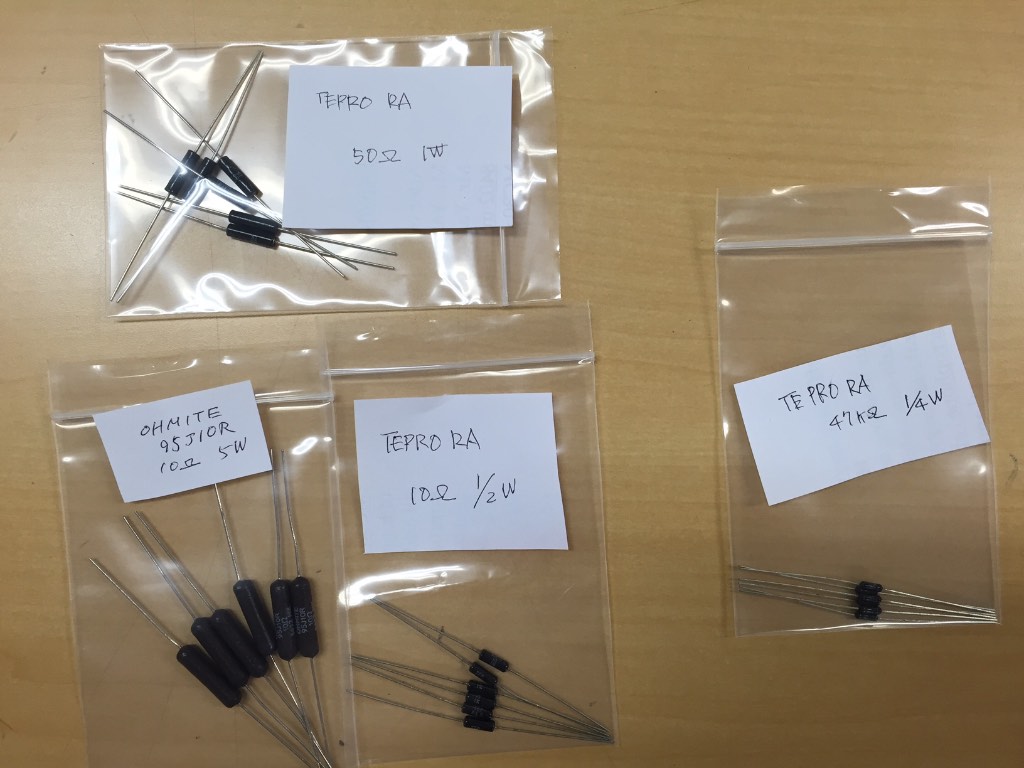Ron, Leo, and I got together last weekend to listen to a trio of vintage McIntosh MX110s variously modified by Ron-san with Real Sound modifications as suggested by Yazaki-san, which are similar to the modifications Yazaki-san has performed on his personal vintage Marantz 7 preamplifier.
Prior to being modified by Ron-san, two of the MX110s were restored - mine and George's - by the vintage McIntosh team of Tom Manley & Terry DeWick at McIntosh Home Audio & DeWick Repairs.
All three had Modifications A & B & C installed in them by Ron-san, which I'll summarize for you.

MX110Z Modification A replaces R88 & R90 (upper left) and R89 & R91 (lower left) with Tepro RA 47KΩ metal film resistors.
Modification A:
Modification A replaces the stock 56KΩ phono stage input resistors at R88 & R90 (left inputs) and R89 & R91 (right inputs), for PH-1 and PH-2, with Tepro RA 47KΩ metal film resistors, which Yazaki-san considers to be the very best for use in this application (the 4 black resistors in the photo below).
Yazaki-san told me that the phono stage’s sound quality depends mainly on this resistor, and that “Gary-san (Tepro) said it was developed special for audio use. For about this resistor, Banno-san and I have never found the weakness of its sound. It is a very rare case for us.”

MX110 Modification B replaces the pairs of stock 0.1uF capacitors at C93 & C95 and C94 & C96 with 0.22uF Arizona Capacitors.
Modification B:
In Modification B we made changes to the first stage cathode follower of the high level input, by replacing two key pairs of 0.1uF capacitors at C93 & C95 and C94 & C96 with the superb 0.22 uF Arizona Capacitors.

Arizona Capacitor's Red Cactus in the MX110Z's first stage cathode follower of the high level input.
Yazaki-san characterized the sound of the Red Cactus, Blue Cactus, and Green Cactus Arizona Capacitors like this: the Red Cactus has a “genuine and pure sound, full of fascinations & passions like beautiful art”; the Blue Cactus has a “gorgeous vintage American tone color, open and natural”; and the Green Cactus has a “noble European timbre, smoother and more open air character”.
Yazaki-san had told me that the FM tuner's sound quality and AUX inputs sound quality would also be improved with Modification B.
For Modification B we put the Red Cactus in my MX110, the Blue Cactus in George's MX110, and the Green Cactus in Leo's MX110, so we could get an idea of their sound differences.
Modification C:
Modification C involved changes to the MX110Z’s power supply at the R116/R117 (above), and the C1, C2, and C3 positions (below).
1. The first modification is at R116, the 47 KΩ resistor, which Yazaki-san recommended we change to the Tepro 47kΩ resistor. Yazaki-san said, “Cathode resistor decides the sound because the signal current flows through this resistor.”
2. The second modification is at C1, where we added a SPEC Ruby-Mica capacitor (MC103DA, 0.01μF / 500VDC ) to the circuit. Yazaki-san said, ” Bridge rectifier circuit has good efficiency but diode’s switching noise level and distribution might be higher or wider than half-wave or full-wave rectification. And mica capacitor’s outstanding performance for high frequency could allow these noise to be able to terminate to the ground. I hope some effects would be promising. By the way, the Marantz Model 7’s plate power supply adopted half wave rectification. I imagine it would be one of the secrets of the sound of the Model 7.”
3. The third modification is to add in C2 & C3 to the circuit as either the Arizona Capacitor Red, Blue or Green Cactus capacitors (0.22μF / 600VDC). Yazaki-san said this modification was to, “strengthen or lower impedance of the plate power supply. Please select by Jeff-san’s inspiration . Because that each color cap could improve the sound, but If you like Red 0.22 for C93-C96, I would like to suggest you to use Blue or Green. Red with Blue or Red with Green could compensate the character of Red.”

Modification C: Arizona 0.22uF Green & Blue Cactus capacitors used in the power supply modifications of the MX110z.
As you can see in the photo above, for my MX110Z we went with Blue & Green Cactus capacitors in C2 & C3 per Yazaki-san’s recommendations.
I suppose I should tell you about the state of my system when Ron, Leo, and I listened to The Trio of MX110s so you have a little bit of a reference for the overall system context.
We used my Tannoy Westminster Royal SE loudspeakers, which I have wired internally with Western Electric WE16GA wire.
The Western Electric WE16GA wire is connected directly to the Tannoy Dual Concentric drivers in the WRSEs, then routes through the WRSE cabinets out to the Duelund CAST external crossovers, which I wrote about in the Duelund-WRSE Project in Issue 70 of Positive Feedback.
In the C1 position of the Duelund CAST crossovers I used the 6.8uF Duelund CAST silver capacitors, along with the Duelund CAST silver autotransformers, that I wrote about in the Duelund-WRSE Project Part 2 article in Issue 74 of Positive Feedback.
The amplifiers were the Real Sound modified vintage McIntosh MC30 monaural amplifiers that I wrote about in Adventures in Real Sound With Mr. Shirokazu Yazaki in Issue 81 of Positive Feedback. Interconnects were all Belden 8402.
The front end was the Garrard Project 2015 that I wrote about in Issue 79 of Positive Feedback, along with the excellent Intact Audio dual-mono step-up transformers for my Ortofon SPU Classic GM MkII stereo phono cartridge.
Listening Impressions
Ron, Leo, and I listened to each of the three modified vintage McIntosh MX110s and were impressed with how good they sounded, and how different they sounded from each other!
Each of the modified MX110s exhibited different sonic & musical strengths & weaknesses, and it was apparent that it was going to take more than just a quick listen to fully characterize the results of the modifications.
The differences between the three modified MX110s are two-fold, the first being the identity of the pair of 0.22 uF Arizona Capacitors used in Modification B to replace the two key pairs of 0.1 uF capacitors at C93 & C95 and C94 & C96, and secondly the identity of the C2 & C3 combination of Arizona Capacitors added to strengthen the power supply in Modification C.
The rest of the components used in the modifications are the same between the three MX110s (i.e. the Tepro RA 47KΩ metal film resistors and the 0.01μF SPEC Ruby-Mica capacitors).
I had to leave for a week on a business trip to Chicago related to the day job, which fortunately included a dinner where I got to listen to some great live jazz guitar playing.
Now that I'm back and mostly settled in, I wanted to do some more extensive listening and report on the results.
The 'Stock' Vintage MX110Z as Restored by Terry DeWick
First of all, I suppose I should comment on how a 'stock' vintage MX110 as restored by Terry DeWick sounds, before I get into what the modded MX110Zs sound like.
Well, for my tastes, the 'stock' vintage MX110Z is about as perfect as I could wish for from any preamplifier, with lots of natural sounding detail, a big spacious soundstage with well-defined images, and an effortless, liquid, rich musicality that is full of color, life, and gorgeous tone. It is very even bottom-to-top, with not a trace of glare or harshness, just a superbly well-crafted overall balance.
Here's what I said about the vintage MX110Z in the article that I wrote in Issue 77 of Positive Feedback:
"I can say that playing records through the vintage McIntosh MX110Z's phono section makes me happy as well, and depending on your hi-fi priorities it might do the same for you. So what is it about the MX110Z that makes me so happy?
Simply put, the MX110Z excels at playing music in an authoritative and vivid way that is very emotionally engaging. First of all, the MX110Z presents melodies, harmonies, and rhythms with a natural life-like momentum & dynamics (albeit with a very slight dynamic diminution at the micro & macro extremes compared to some of the very best modern gear), and tempos are portrayed so that both the mood and speed of the music are conveyed through it, just like with music in real life. Secondly, the MX110Z's tonality is superb by any standard past or present, and it excels at the reproduction of the textures, colors, tones and overtones that timbral listeners will revel in.
The MX110Z—and vintage McIntosh gear generally—plays music at live-like loudness (dB) levels very realistically, or as Steve put it, 'spooky real.' When I'm really into listening to an album for the live-like music experience, I like the loudness level to be similar to live loudness levels for the kind of music I'm listening to, which for the kind of music I listen to the most, jazz, usually means around 80dB or louder. I've also found the MX110Z to be very musically compelling when listening to music across a wide spectrum of volume levels too, from very soft background levels, all the way to blow-the-windows-out rock & roll levels.
The MX110Z is nicely transparent, which allowed me to hear deeply into the music-making fabric of a recording, and it throws a nice big three-dimensional soundstage with a large sense of ambient space, putting it in the same general league as any of the modern high-performance gear I've had in my system to listen to. The MX110Z isn't quite as resolving as some of the most resolving modern gear, but it's close enough that I didn't care."
If you want to get the full scoop on the 'stock' unit go ahead and read through The Vintage McIntosh Experience: A Musical Ride With The MX110Z Tuner/Preamplifier and the MC30, MC225, and MC240 Amplifiers in Issue 77, it'll be time well spent.
I liked the sound of my MX110Z so much, that for my tastes I was a little worried that it would not be possible to improve upon it.
Jeff's MX110Z with Red Cactus for Modification B and Blue & Green Cactus for Modification C
First up I thought I'd listen to and report on my MX110Z with the pair of 0.22uF Red Cactus capacitors that were used for Modification B to replace the pairs of 0.1uF capacitors at C93 & C95 and C94 & C96, and the 0.22uF Blue & Green Cactus capacitors that were added as C2 & C3 as part of Modification C, to strengthen the power supply.
One thing I noticed when Ron, Leo, and I, were listening to the modified MX110s was that it took them a while to warm up to sound their best, say an hour or so, so they don't lend themselves to quick comparisons very well. So they need to be given plenty of warmup time, and then some thoughtful listening to get their full measure of performance.
I should also point out that all the components installed are not fully run-in yet, so all of these units are going to need quite a lot more time on them before their full performance becomes evident.
First up for a listen was the 45 r.p.m. mono version of Billie Holiday's Body and Soul on the Analogue Productions label that was mastered by George Marino at Sterling Sound.
Released originally in 1957 on the Verve label, Body and Soul features Billie Holiday on vocals, Ben Webster on tenor sax, Barney Kessel on guitar, Harry "Sweets" Edison on trumpet, Jimmy Rowles on piano, Red Mitchell on bass, and Larry Bunker on drums.
For playback I used my Ortofon SPU Mono CG 25 Di MkII phono cartridge straight into the MX110Z's phono input #1.
The first thing I noticed was that the modifications resulted in some unpleasant forwardness in Billie's vocals that were not present in the unmodified MX110Z. The overall tone was darker and richer than with the stock MX110Z, which I liked, and Ben Webster's tenor sax sounded gorgeous, as did Sweets Edison's muted trumpet, and which notably sounded about as realistic as I've ever heard a muted trumpet sound on the song Body and Soul.
From a sonic standpoint, the sense of space produced by the modded MX110Z was clearly greater than with the stock MX110Z, filling the entire room in impressive fashion. The transparency was also improved, with more realistic timbral texture in evidence, and the dynamics - particularly the macro dynamics - were more apparent.
On Darn That Dream the upper midrange forwardness in Billie's vocals was distracting, but again Edison's muted trumpet sounded as perfect tonally as you're ever likely to hear, with none of the unpleasantness that you can sometimes get with muted trumpet. Red Mitchell's bass lines had good pitch definition, and sounded about like an upright bass does in real life.
I loved the way the modded MX110Z handled tone and timbre, it was superb, and better in that regard than the un-modded MX110Z. Transparency and sense of space were noticeably improved by the modifications, however, I thought the macro-dynamics were almost too powerful with the modifications, causing vocals to get shouty. With Billie's vocals I found the modifications produced an upper midrange emphasis that I found unpleasant, which is a deal breaker for me, and I found the stock MX110Z much better in that regard.
As well as bringing along some great wines for us to drink, my buddy Leo also brought over a nice gift for me, the Bob Dylan soundtrack album for Pat Garrett & Billy The Kid that was released in 1973 on Columbia (PC 32460), which is a great sounding album - thank you, Leo, you're awesome!
There's lots of talent on this album, like Bob Dylan, Roger McGuinn, Booker T, Terry Paul, Jim Keltner, Carl Fortina, Fred Katz, Bruce Langhorn, Russ Kunkel, Carol Hunter, Donna Weiss, Priscilla Jones, Byron Berline, Jolly Roger, Brenda Patterson, Gary Foster, and others I probably missed mentioning. Musically this is a really enjoyable album, and if you enjoy folk rock, I'd start checking the used records stores to see if you can find a copy. I really enjoyed it! Thanks again, Leo!
For playback on Pat Garrett & Billy The Kid I used my Ortofon SPU Classic GM MkII stereo phono cartridge into the Intact Audio dual-mono step-up transformers, and into phono input #2.
The first thing I noticed when the stylus touched down on the Pat Garrett & Billy The Kid album was the huge sense of space that filled my room, and the very wide soundstage with instruments spread across it, as well as a nice sense of depth.
I thought the sound on Knockin' on Heaven's Door was nicely transparent, and there were lots of natural details evident, with a good sense of timbral realism, and the vocal harmonies were gorgeous. On the down-side, I found there was that same unpleasant upper midrange emphasis that I heard on Body and Soul. The micro-dynamics were good, but once again I thought that the macro-dynamics were a bit overdone, and that combined with the upper midrange emphasis made listening unpleasant and harsh at times, and I found myself wanting to turn the volume down.
Jim Hall's Concierto was recorded at Van Gelder Studios in April, 1975, and features an all-star cast of musicians. Paul Desmond on alto saxophone, Ron Carter on bass, Steve Gadd on drums, Jim Hall on guitar, Roland Hanna on piano, and Chet Baker on trumpet.
For playback on Concierto I used my Ortofon SPU Classic GM MkII stereo phono cartridge into the Intact Audio dual-mono step-up transformers, and into phono input #2.
The first thing I noticed when the stylus touched down on Concierto was that Cole Porter's You'd Be So Nice To Come Home To had a real sense of life along with a snappy tempo that really high-lighted Jim Hall's guitar playing. As was the case with other albums, the modded MX110 threw an enormous sense of space, and had a wide - and in this case - a particularly deep soundstage. I didn't mention it earlier, but the modded MX110Z also improves upon the imaging of the stock unit.
Timbral textures are very natural with the modded MX110Z, and detail recovery is greater than with the stock MX110Z. Ron Carter's bass sounded really good, with very good pitch definition, and a propulsive drive.
The Red, Blue & Green Cactus modded MX110Z sounded impressive on Concierto, and wasn't hindered by the upper midrange prominence as on other recordings.
However, I have to say I preferred the overall balance of the stock MX110Z to the Red, Blue & Green Cactus modified version, as the overly vivid/prominent upper midrange combined with increased macro-dynamics made it sound unpleasant on most music - particularly vocals - I've listened to.
On the positive side, the modded MX110Z had gorgeous tone with timbrally realistic textures, a richer & darker presentation, a huge sense of space, better imaging, greater transparency, and more detail recovery.
However, in spite of all the positives, I can't recommend using the Red Cactus capacitors for Modification B to replace the two key pairs of 0.1uF capacitors at C93 & C95 and C94 & C96, it just made the presentation too forward in the upper midrange, and more often than not it made the music unpleasant to listen to, making the presentation shouty and forward.
It turns out that modifying the MX110Z tuner-preamplifier was not as straightforward as it was when we modified the MC30 monaural amplifiers, which turned out spectacularly well using similar components & techniques. So clearly we will have to do something different for Modification B than the Red Cactus capacitors to get the sound dialed in to my liking.
***
Like Gareth, I've been wondering if changing the the phono input resistors in Mod A from 56KΩ to 47KΩ was responsible for the overly aggressive upper midrange from the MX110s, rather than the Red Cactus cap’s in Mod B as I had speculated above.
The upper midrange had become aggressive enough on most music that I abandoned listening to the MX110s until we got the situation figured out. In conferring with Yazaki-san, he has had very good results with the 47K Tepro RA’s in a similar application, but suggested a couple of ideas to try for the MX110 to see if that didn't help sort things out.
We’ll try 56KΩ Tepro RA’s to replace the 47KΩ Tepros, but it will take a while to get some from Gary at Tepro, so in the meantime Yazaki-san has sent some other Tepro & Ohmite resistors to try in series connection with the Tepro RA 47KΩs in Mod A, and thus the 'Resistor Adventure' is born.
Another thing we're going to try is using a pair of the original 56KΩ MX110 resistors on Phono 2 in George's Blue Cactus MX110, and A-B them with the Tepro RA 47KΩs on Phono 1. Should be interesting!
Check back for more shortly!
Thanks for stopping by!




